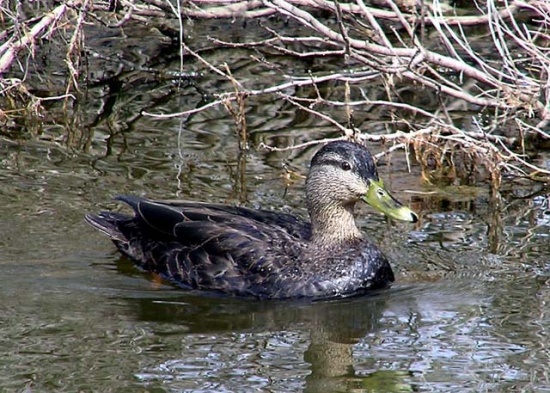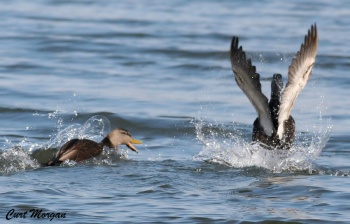- Anas rubripes
Identification
L. 19-22 in (48-56 cm)
- Large dabbling duck
- Olive or dull yellow bill
- Sooty brown body
- Conspicuous white wing linings
- Lighter head and neck
- Orange legs
- Dark eyes
- Shiny purple-blue speculum
- Not bordered by white
Similar Species
Female Mallard paler and sandier, with bill mottled with orange and black, and whitish tail feathers.
Distribution
A bird of eastern North America, breeding in Canada to the Arctic Sea and in northern-most eastern USA west to Wisconsin and Minnesota. It winters from the Canadian border south in the US, but does not reach the Gulf of Mexico.
This duck is a rare vagrant to Great Britain.
Taxonomy
This is a monotypic species[3].
Two subspecies are recognised by some authorities: A. r. rubripes and A. r. obscura4
They regularly breed with Mallard ducks and are closely related to them. Some authorities believe them to be a dark variant of Mallard. 2
The hybrids are difficult to distinguish in the field. Hybrid females appear to die before reaching sexual maturity leading to the belief that they are separate species.1
Habitat
They breed on lakes, ponds, rivers, freshwater and coastal marshes.
Behavior
Diet
These birds feed by dabbling in shallow water, and grazing on land. They mainly eat plants, but also some mollusks and aquatic insects.
Breeding
The clutch consists of six to fourteen greenish-buff eggs which usually hatch at about 30 days.
Vocalization
See Mallard
References
- Wikipedia
- Clements, J. F., T. S. Schulenberg, M. J. Iliff, D. Roberson, T. A. Fredericks, B. L. Sullivan, and C. L. Wood. 2016. The eBird/Clements checklist of birds of the world: v2016, with updates to August 2016. Downloaded from http://www.birds.cornell.edu/clementschecklist/download/
- Avibase
Recommended Citation
- BirdForum Opus contributors. (2025) American Black Duck. In: BirdForum, the forum for wild birds and birding. Retrieved 24 April 2025 from https://www.birdforum.net/opus/American_Black_Duck
External Links
GSearch checked for 2020 platform.





